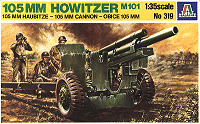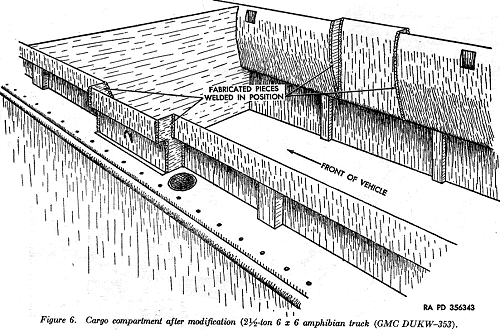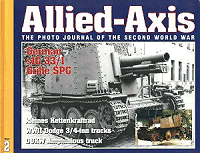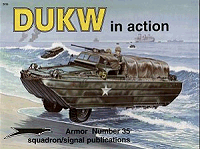

DUKW
with 105mm Howitzer
Italeri Kit #6429
1:35th Scale
First Look by Terry Ashley


Introduced into service 1943, the DUKW served first in Sicily, then on through the Italian and North-West European campaigns and also in the Pacific although the tracked LVT series were more common there and it was also used in Burma. It continued in use in military service for many years post-war, several found their way into civilian agencies as emergency and rescue vehicles, others have been used with greater or lesser degrees of modification as pleasure craft and several preserved ones appear at vehicle rallies.
The
Kit:
Following their earlier DUKW, Italeri have now re-released the kit with the
inclusion of the 105mm Howitzer.
The kit is basically the same as the first release plus the addition of the four wheel well spats, an extra tyre ‘bumper’ and some wheel chocks with altered parts 21A and 22A (see below) so check the review of kit 6392 here for a rundown on the kit contents.
 Also
included is the M2 105mm Howitzer which is exactly as it was when released
as kit No.319 some years back and still includes the three figures which are
rather basic by today’s standards. The 105 is not bad for its age as
it comes from the time when Italeri kits had very fine parts and
crisp clean mouldings and in some respects better than some current Italeri kits.
There are some sizable pin ejector marks to be removed from many of the parts
which were also
a characteristic of past Italeri kits but nothing that can’t be
dealt with.
Also
included is the M2 105mm Howitzer which is exactly as it was when released
as kit No.319 some years back and still includes the three figures which are
rather basic by today’s standards. The 105 is not bad for its age as
it comes from the time when Italeri kits had very fine parts and
crisp clean mouldings and in some respects better than some current Italeri kits.
There are some sizable pin ejector marks to be removed from many of the parts
which were also
a characteristic of past Italeri kits but nothing that can’t be
dealt with.
The new box is also thankfully quite a bit larger than the first kit to accommodate the extra 105mm howitzer parts.
The only alterations to the original kit parts are to the side panels of the cargo bay (parts 21A and 22A) which have two “notches” added to accept the 105 wheel hubs due to the gun being slightly too wide to fit into the cargo bay as it comes.

This notch was incorporated into the side panels in DUKWs, from June of 1950. During WWII, the M2 series 105mm carriage frequently used narrower wheels and tires (7.50-24), mainly as a rubber economy measure. With these mounted the M2 carriage would fit in the bed so long as the tires were on blocking to keep the wheel nuts above the bed coaming. It's also possible that some impromptu "body work" was performed to allow the wheel hubs to clear. After the war, the specified 9.00-20 wheels and tires were used which are what are in the 105mm kit. (Thanks to Kurt Laughlin for this additional information and the image below.)

This and the drain holes on the side panels means only a post WWII vehicle can be made from the kit parts as they come in the box without modification.
A length of twine is included for the tie down ropes for securing the gun to the cargo bay and the instructions have a diagram showing the positioning of the ropes.
 A
new decal sheet is included with markings for four DUKWs, two used by the USMC
at Iwo Jima in 1945 and is finished in the distinctive Olive Drab/Dark Sand
Yellow/Light Sand Yellow cam scheme and two from US Army units in Germany 1945.
One of these is from the Seventh Army and carries the colourful marking “Pistol
Packing Mama” on both sides of the hull and is shown on page 67 of Allied & Axis No.2, the other has the nickname “The Texan” but is otherwise unidentified.
A
new decal sheet is included with markings for four DUKWs, two used by the USMC
at Iwo Jima in 1945 and is finished in the distinctive Olive Drab/Dark Sand
Yellow/Light Sand Yellow cam scheme and two from US Army units in Germany 1945.
One of these is from the Seventh Army and carries the colourful marking “Pistol
Packing Mama” on both sides of the hull and is shown on page 67 of Allied & Axis No.2, the other has the nickname “The Texan” but is otherwise unidentified.




|
|
|
 WWII
US War Department WWII
US War DepartmentTechnical Manual CD-ROM TM9-802 US 2 1/2 Ton, 6x6 Amphibian Truck (DUKW - 353) Easy 1 Productions #T025 |
 Allied-Axis Allied-AxisThe Photo Journal of the Second World War No.2 Ampersand Publishing. The publishers of MMIR magazine. 96 pages soft cover. |
 DUKW
in Action DUKW
in ActionSquadron/Signal books #2035 ISBN 0-89747-372-8 |
|
|
Page Created 12 March 2004
Updated 13 March 2004